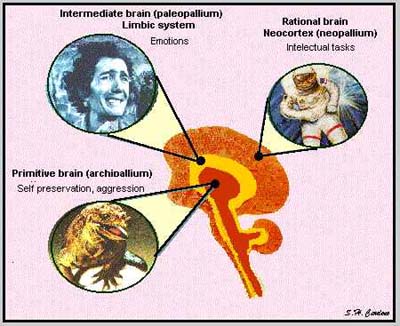Serendip is an independent site partnering with faculty at multiple colleges and universities around the world. Happy exploring!
What is Intelligence
How do we define intelligence? What does it mean to be highly evolved? Why are humans considered to be "higher" vertebrates than frogs?
 Often we define intelligence with respect to human qualities. Thus, as we tend to consider ourselves as the most intelligent species, we compare other species to ourselves. Yet, is this really possible? One scientist suggests that humans tend to ignore any intelligence that is somewhat different than our own: "We willingly accept the idea of intelligence in a lifeform only if the intelligence displayed is on the same evolutionary wavelength as our own. Technology automicatically indicates intelligence. An absence of technology translates into an absence of intelligence."
Often we define intelligence with respect to human qualities. Thus, as we tend to consider ourselves as the most intelligent species, we compare other species to ourselves. Yet, is this really possible? One scientist suggests that humans tend to ignore any intelligence that is somewhat different than our own: "We willingly accept the idea of intelligence in a lifeform only if the intelligence displayed is on the same evolutionary wavelength as our own. Technology automicatically indicates intelligence. An absence of technology translates into an absence of intelligence."
There is no certain basis for the assumption that all intelligence is human-like intelligence. Indeed, there are undeniable trends, such as large brains in mammals and larger neocortices in primates, but to generalize these correlations cannot always be done.
Truly, intelligence seems to be relative, in that it evolves to fulfill the needs of the particular species. How, then, can we truly compare the intelligence of a crocodile with that of a whale or that of a human?
Evolutionarily speaking, scientists agree that organisms seem to have become more complex behaviorally. Some argue that this is correlated with increased brain size. Changes to the brain have occured at specific structures, for example the neocortex, not simply with overall brain size. Go to this website for a more in-depth look: "Brain Size and Evolution".
Another method for observing evolutionary trends is to look at the components of the human brain (as an example of a highly "evolved" and "intelligent" species) and trace the function evolutionarily. For example, we can first compare it with a reptilian brain (an example of a less "intelligent" organism). I did this in a picture form on another page. If we look at a reptilian brain we see structures that are observed in the human brain stem and cerebellum. In reptiles the brain stem and cerebellum dominate, as these parts of the brain control balance, vital life functions (breathing, heartrate), and movement.
The next component of the human brain to explore is the limbic system. Some scientists refer to this as the "paleomammalian brain". In other words, this part of the brain corresponds to the brain of most "early" mammals. The function of the system is predominantly emotion, instincts, hunger, fighting/fleeing, memory, sensory input, and sexual behavior.
Finally, the neocortex is assumed to be the superior ("neomammalian") part of the brain, which makes up the majority of the cerebral hemispheres. Species which are considered to be highly intelligent, such as humans and dolphins, tend to have large amounts of neocortex. This structure is assumed to be responsible for higher cognitive functions and is associated with greatest behavioral complexity. While all mammals have a neocortex, some (for example: a mouse) have less cortical folding than others (for example: a human). Interestingly enough, a mouse whose cortex has been highly lesioned can act in a relatively normal way (superficially) while a human without a cortex is essentially non-functioning.
This is an interesting representation of the "Triune Brain" hypothesis:




Comments
Post new comment